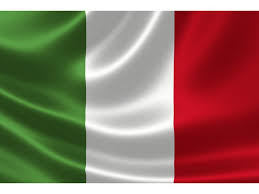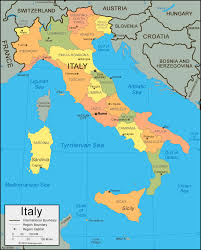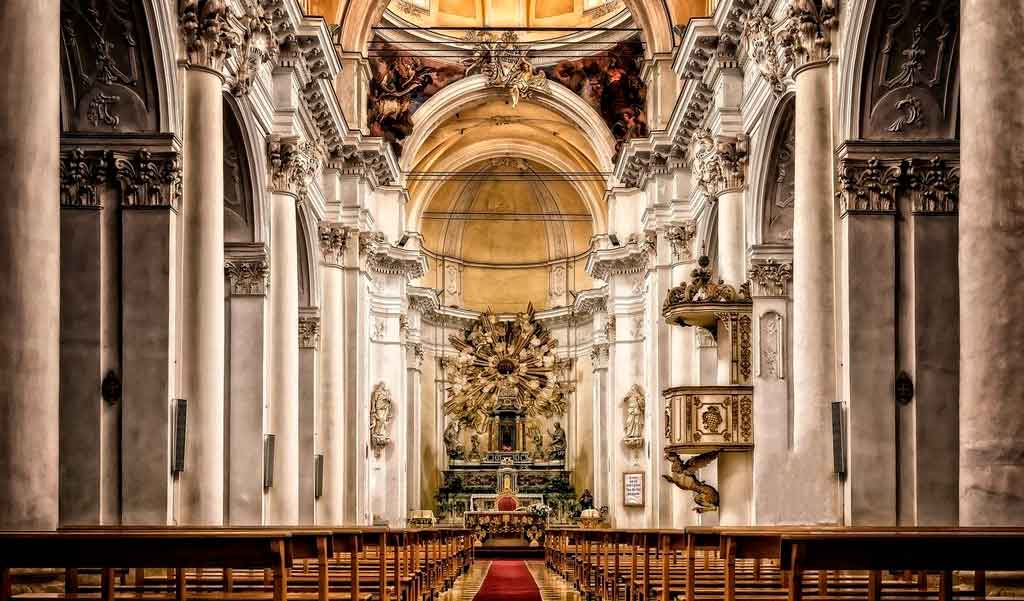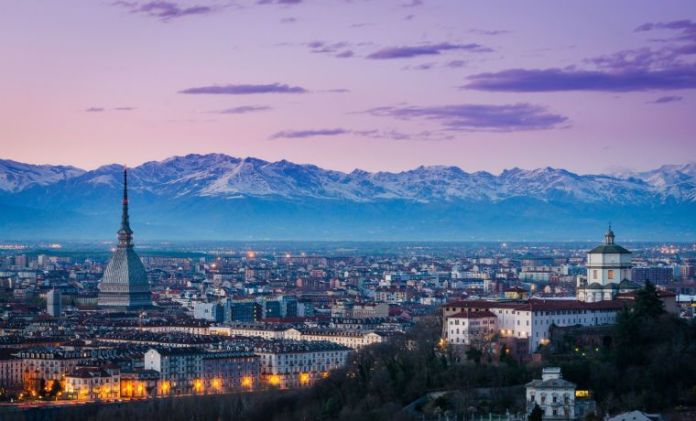Italy is a European country located in the south of the continent, its territory is bathed by the Mediterranean Sea; it is limited to the north with Switzerland, Austria and Slovenia; and to the northwest, with France.
The country in question has an estimated population of 59.8 million inhabitants, spread over an area of 301,268 km², the main city being Rome, the national capital.

Italy is a developed country, occupies a prominent place on the world stage, as it has one of the largest GDP (Gross Domestic Product) on the planet, in addition to integrating the main international organizations, such as the G-8, WTO (World Trade Organization ), NATO (North Atlantic Treaty Organization) and creator of the European Union.
The country’s topography is quite rugged, the highest point being Monte Branco, with 4,810 meters of altitude. There are two volcanoes on Italian territory, Mount Etna and Mount Vesuvius. There are several types of climates in Italy, with emphasis on the continental, altitude and Mediterranean type (with hot and dry summers and cold and rainy winters).
There is an economic disparity within Italian territory, which is explained by the fact that the north is quite industrially developed, while the south is quite agricultural. The country imports about 75% of the energy consumed and a high amount of raw material. The main Italian export products are: automobiles (Fiat, Aprilia, Ducati, Piaggio, Ferrari, Maserati, Lamborghini and Pegani), chemicals, petrochemicals, electrical products, appliances, aerospace and defense technology, firearms, fashion and food . A major activity for the Italian economy is tourism, since the country has the largest number of UNESCO world heritage sites. This factor makes the country one of the main tourist destinations in the world, receiving about 37 million tourists annually.
The Italian people emerged from the mixture of diverse peoples, such as the Latins, Sabines, Umbrians, Samnites, Oscans, Etruscans, Greeks, Celts, in addition to Germans, Saracens and Normans. The country’s official language is Italian, however, others are spoken by the population, such as: Sardinian, Neapolitan, Veneto, Friulian, French, German and Slovenian.
The country’s main religion is Roman Catholicism, but many others are practiced, such as Orthodox Catholicism, Protestantism, Jehovah’s Witness, Judaism, Islam, Buddhism, Sikhs and Hinduism.
Italy flag

There is no agreement on the meaning of the colors of the flag of Italy, but three versions are the most accepted.
One of the explanations identifies green to nature; the white, to the snow of the Alps; and red to blood spilled during the Italian wars of unification and independence.
The religious interpretation comments that colors are related to the three theological virtues. Thus, green means hope; white, faith and red, charity.
Others say that the origin of this color would be the union of the colors of the flag of Milan, white and red, with the uniform army of the official Milanese guard, which was green.
History of the flag of Italy
The origin of the flag of Italy dates back to 1794, when the northern part of the Italian Peninsula was occupied by Napoleonic troops. There, the French, led by Napoleon Bonaparte, defeated the Austrians who were the lords of the region.
Once independence was conquered, the Cispadana Republic was founded, which adopted a tricolor flag in green, white and red. In this way, the design chosen was the same as that of the then recently proclaimed French Republic, with only the color green instead of blue.
As Italy’s unification process began in the north of the peninsula, the emblem was eventually elected to represent the new independent country. When the kingdom of Italy was formed, the flag carried the shield of the Royal House in the center, over the white band. With the proclamation of the Republic, this symbol was removed.
The current format of the Italian flag began to be used since June 19, 1946, but it was only officially defined on January 1, 1948.
The flag festival of Italy is celebrated on the 7th of January.
What was Italy’s first capital?
If you are one of those people who really know everything about Italy, you know that the country’s first capital was another, not the current one, Rome.
The city of Turin (for Italians, Torino) was the first capital after unification in 1861. It was in this region that the movement began to take shape.
One of the oldest Italian cities, founded in the 3rd century BC, was the residence of Casa de Savoia, the royal family of the Piedmont region. Vittorio Emmanuelle II, head of the house, was chosen as the first king of unified Italy.
For four years, Turin remained with the status of Italian capital, losing the post in 1865 to Florence. It was only in 1871 that Rome was recognized as the country’s capital.
What currency is used in Italy?
Since 2002, Italy has adopted the euro as its official currency , as have most countries that are part of the European Union.
For those who like curiosities about Italy, the currency in force before the adoption of the euro was the Italian lira.
Those who travel to the country are often in doubt about which currency to take. As much as the dollar is accepted in many places, it is best to actually have the euro on a journey through wonderful Italian destinations.
Map of Italy

Pomegranate

The capital, Rome, is a destination that cannot be missed in the itinerary of any traveler in Italy. There are several attractions that exalt Roman culture and history , being one of the most beautiful postcards around the world.
Important symbols of the Roman Empire, the Colosseum , the Pantheon and the Roman Forum are important landmarks of the city, be sure to visit them.
It is in Rome that the Vatican City, city-state that houses and St. Peter’s Basilica and the official residence of the Pope is located.
Around the city, take the time to also visit important squares, such as Piazza Navona and Piazza Venezia, and throw a coin for luck at the Trevi Fountain.
Milan
Known for being the capital of fashion, Milan is full of stores of major brands that dictate trends around the world.
But there is still a lot to do in Milan besides fashion. The city has monuments and sculptures of historical value capable of filling the eyes of any visitor.
The Milan Cathedral , with its columns and structures made entirely in marble, is the third largest church in the world. It is located in Piazza del Duomo , another busy tourist spot in the city.
Be sure to also visit the Church of Santa Maria delle Grazie , where is one of the most important Renaissance works, “The Last Supper”, painted by Leonardo da Vinci.
Venice

Venice is one of the most popular destinations for couples worldwide. Not for nothing, it is known as the “city of love”, inspired also by the channels that cut through it.
It is almost impossible to get to know Venice and not take a gondola ride through the canals, admiring the city from a different angle.
There are also incredible places to visit there. The St. Mark’s Cathedral , built in the ninth century, has floors and mosaics of gold and is one of the most visited monuments.
Also visit the Ducal Palace , relevant in Venetian politics, Piazza San Marcos – where the basilica is located – and the Leonardo da Vinci Museum .
Florence
Cradle of the Renaissance, Florence is practically an open-air museum, with its cathedrals, monuments and historic architecture.
The Piazza del Duomo attracts many tourists and is where is located the Santa Maria del Fiore cathedral , or Duomo of Florence, main postcard of the city.
In the upper part of the city, Piazzale Michelangelo offers a panoramic view of Florence and houses one of the replicas of Michelangelo’s famous sculpture of David.
The original work can also be visited in the city. It is located inside the Galleria Dell’Academia , along with other works of historical importance.
Naples

Despite not being among the main tourist destinations in Italy, Naples has attractions capable of winning over any traveler who includes her in her itinerary.
Visit the Duomo of Naples , which is in the central region of the city, and the Chapel of Pio Monte della Misericórdia , where one of Caravaggio’s main works, “Seven Acts of Mercy” is.
The Via San Gregorio Armeno is one of the most popular small streets with wide range of shops and great boutiques for those who want to shop.
And if you go to Naples, be sure to try the local pizza. The city in the south of the country is known as the birthplace of pizza in Italy.
All about Italy : geographic curiosities
Did you know that, like Brazil, Italy is divided into regions, even though it does not have territorial dimensions? And that the climate in the country varies between these regions?
For you to know everything about Italy, check out some curiosities about the country’s geography that will increase your knowledge and get you ready to know the main Italian destinations.
What are the characteristics of Italy?

Italy’s historical fragmentation has reflected on the country’s current disposition. The Italian territory is divided into 20 regions , something equivalent to the Brazilian states.
These divisions were instituted by the 1948 Constitution to bring more autonomy. Within each region there are provinces, which total 110 spread across the country.
Some regions have great relevance in the country. The Lombardy , located to the north, stands out for its economy. In Tuscany , for example, tourism is one of the strong points, with beautiful cities like Florence and Siena .
What is the area of Italy?
Italy has a territory of 301,230 km², including the islands to the south that are under Italian rule. In this space, the more than 60 million inhabitants place the country as the fifth most populous in Europe.
The Italian relief is quite varied. It is possible to see mountain ranges and mountain ranges to the north, where the country borders Switzerland and Austria, and in the central region.
It is in the north that is Monte Branco, the highest point in Italy , with 4,180 meters of altitude.
The plain region is known as Padana (or Plain of the Powder, because of the name of the river that cuts it). It stretches from the Alps and the Apennines and through important cities like Turin and Milan.
There is also the Italian coastal region , surrounded by mountains and cliffs that make up a breathtaking landscape. Italy is bathed by the Mediterranean Sea and its beaches are clear, almost transparent.
The lush Italian vegetation, on the other hand, consists of woods and forests, with beautiful green areas especially in its lowland region.
What is the predominant climate in Italy ?
The Italian climate tends to vary according to the regions of the country, mainly due to the influence of mountain ranges.
In the north , the continental climate leaves temperatures lower for much of the year, including the possibility of snow.
In the south of Italy , from Florence down, the Mediterranean climate predominates , characterized by a dry and hot summer, and mild temperatures for the rest of the year.
When is the best time to visit Italy?

Do you have any doubts about when to travel to Italy? So know that the country is ideal to be visited at any time of the year .
The high Italian season runs from March until September, when the European summer ends. It is the period in which the country receives more tourists due to the milder temperatures and a more festive climate.
Between October and February, thermometers indicate lower temperatures, typical of autumn and winter. But the period is also very likely to visit Italy.
Wrap up well and witness the Italian charm during the coldest period – of course, accompanied by great wine.
All about Italy : renowned gastronomy
One of the highlights of Italy is its gastronomy recognized worldwide . Those who know the country and try the local cuisine know that the food is a landmark of the place.
Who has never heard of the fame of Italian pizzas and pastas? With simple recipes and striking flavors, they conquer the taste of any visitor.
The best accompaniment is a good wine. Italy is one of the main producers of the drink in the world, benefiting from the quality of the grapes grown there – there are about 350 different types .
Between meals or after them, also enjoy a good espresso, Italian coffee, and gelato, the legitimate Italian ice cream that is famous worldwide.
Territory and population
The country’s territory covers about 301,338 km² and has a temperate climate. With 60.6 million inhabitants, it is the fifth most populous nation in Europe and the 23rd in the world.
The legacy that left us
Among the many legacies of the Roman domain are the use of languages derived from Latin, the numerical system, the alphabet, the Western calendar and the emergence of Christianity as an important religion.
And that is why it is impossible to talk about Italy at all without talking about the Roman Empire.
Division of the Roman Empire
From the 3rd century, the Roman Empire was divided in two. The Western Empire, under pressure from barbaric invasions, collapsed in 476, when its last emperor was deposed by the German chief Odoacro, while the Eastern Empire would still survive for another thousand years.
Italian art and culture
It is practically impossible to think of any area of culture and art in which Italy does not have an important influence. Come on: music, painting, sculpture, architecture, fashion, design, gastronomy and cinema say everything about Italy.
The country is home to at least 50 world heritage sites, which include monuments, buildings and cities. Among them, the Colosseum in Rome, the Duomo of Milan, the historic center of Florence, the Tower of Pisa, the archaeological site in Pompeii, the city of Venice. Check out some important names:
Architecture
There are well-known names in the field of architecture, such as Donato Bramante, Gian Bernini, Francesco Borromini, who explored techniques, proportions and materials that made history.
Literature
Countless classics of literature and politics were written by Italian names, such as Dante Alighieri, Machiavelli, Boccaccio, Umberto Eco, Giambattista Vico and Antonio Gramsci.
Painting
In this field, the Italians are practically unbeatable, with Botticelli, Caravaggio, Rafael, Titian, Modigliani.

Gastronomy
As it could not be otherwise, Italian cuisine is one of the highlights of the country. How to talk about everything about Italy, not to mention all the gastronomy that makes anyone’s mouth water.
Ingredients and dishes vary by region. Breads, cheeses and wines are important ingredients in the kitchen, playing different roles with their many variations and laws Denominazione di origine controllata (regulated denomination).
Italian meals
Italian meals consist of three to four dishes. The antipasto is followed by the main dish or piato cousin – pasta, rice or soup. The secondo piato is the main dish of meat or fish with vegetables or salad, I have contoured them.
Fruits, cheese or sweets come next, with coffee – especially espresso – and a digestive drink like grappa or amaro to finish the meal.
Perhaps Massimo Bottura is the best-known contemporary chef in Italy, but it is essential to remember the culinary traditions linked to bread, wine, the production of olive oils, truffles, mushrooms, pasta and sweets famous around the world. Each region has its specialties and they are totally related to the climate, the type of terrain and the local culture.
The weather in Italy
Anyone looking to know everything about Italy is certainly curious about the climate. This is a decisive condition for many people when choosing where to live. The boot country has a narrow shape, that is, the influence of the sea and the Mediterranean climate is felt in almost the entire territory. At the same time, its extension from north to south generates great climatic differences.
The climate in Italy varies between regions. Northern Italy (Milan, Turin and Bologna) has a continental climate, while south of Florence has a Mediterranean climate, with dry and sunny summers. The climate of the coastal areas of the peninsula is very different from the interior, particularly in the winter months. The highest areas are cold, humid and snowy in the winter.
In coastal regions
Coastal regions have a typical Mediterranean climate with mild winters and hot, generally dry summers. There are noticeable differences in temperatures, especially during the winter: in December or January it can snow in Milan at -2 ° C, while in Naples the temperatures are at +12 ° C.
In Southern cities
The altitude influences the climate and temperatures. Southern cities like Potenza (in Basilicata), Campobasso (in Molise) or Enna (in Sicily) have severe winters and average temperatures lower than other coastal locations in the same regions.
What are the best regions in Italy?
I know we repeated this too much, but it really depends on what you are looking for in the country, your lifestyle, the climate you prefer and how much you can spend. There are many variables.
For those who want to know everything about Italy, one of the most relevant information is to understand the country’s organization in regions. There are 20 regions in total, with 110 provinces. Meet some of them:
Lombardy
Located to the north, it is the most important from an economic point of view and its main city is Milan. It has mountains, hills and some famous lakes, such as the Garda, the largest in Italy.
Piedmont
Second largest region in the country, its capital is Turin. It borders France and Switzerland, through the Alps, so it presents a more rigorous winter and influences from the coldest countries in gastronomy.

Lazio
Its capital is Rome and has immense historical and cultural importance. The city is an open-air museum, highlighting the various ruins of the Roman Empire visible throughout.
Campania
Naples, Capri, Pompeii and the Amalfi Coast are some attractions of the region, not to mention the unmissable gastronomy. They say that the best pizzas in the world are in Naples – and who will have the courage to doubt? One is that of the Sorbillo family, where even the Pope has passed on.
Emilia-Romagna
Those interested in the luxury car market may be interested in the region, which is one of the most developed and concentrates famous factories, such as Lamborghini, Ferrari and Maserati. Another landmark of the region is in the city of Bologna, which is the oldest university in the western world, founded in 1088.
Veneto
Its capital, Venice, is the main attraction. For those who want to work in the tourism market, it may be an option, since it receives 60 million visitors each year.
Tuscany
Its fame is due to the production of excellent ingredients, such as grapes and olives. But there are also very important cities like beautiful Florence, with one of the largest concentrations of world heritage sites.
Sicilia
The largest island in the Mediterranean has the Etna volcano in its territory. Although it causes some apprehension, it is undeniable how it benefited the soil and made it one of the most fertile in Europe. It is not by chance that the region produces excellent wines and ingredients.
The economy in Italy
Italy has a market economy characterized by a high GDP, it is the eighth largest economy in the world and the fourth largest in Europe in terms of nominal GDP.
After the Second World War
After World War II, Italy was transformed from an agriculture-based economy to one of the most industrialized countries in the world and a leader in world trade and exports.
World’s largest wine producer
The world’s largest wine producer, Italy is a country known for its influential business sector, innovative car production, industries, appliances and high-quality fashion design.
Effect of covid-19 on Italy ‘s Economy
The European Commission today published the new estimates for the bloc’s economy and pointed to a retraction of Italy’s Gross Domestic Product (GDP) by 11.2% – being the worst scenario among the eurozone countries. According to the report, the pandemic of the new coronavirus (Sars-CoV-2) caused a “deep contraction” of the Italian economy, and the effects of the health crisis will have an “even heavier impact in the second quarter” compared to the first.
As for the third quarter, in the event that there is no second wave of Covid-19, the government’s “economic activity will resume with the help of policies”, with industrial production recovering the fastest. However, tourism and related activities will still need “more time”. As a result, the report points out that the country’s 2021 GDP is expected to rise 6.1%. For the eurozone, the European Commission expects the economy to fall 8.7%, for a 6.1% recovery next year. The biggest falls, after Italy, should be from Spain (-10.9%) and France (-10.6%). The document released by the organization states that there is an “even deeper recession” than expected and with a “broader” crisis
